| Pars p chromosomae |
p-Abschnitt eines Chromosoms, Bezeichnung
für den kürzeren Arm eines Chromosoms |
p-region of a chromosome; the shorter
arm of a chromosome is labelled with p |
Plasmalemma
(= Membrana cellularis)
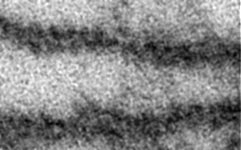 Abbildungen - images
Abbildungen - images
|
Plasmalemm = Zellmembran; äußere
Grenzmembran einer Zelle; sie besteht aus einer Phospholipiddoppelschicht
mit eingelagerten Proteinen, die an ihrer Oberfläche Glykoproteine
(Glykokalyx) tragen.
--> weitere Informationen und Abbildungen |
cell membrane; the membrane that
forms the outer boundary of a cell; consists of a phospholipid double layer
and cholesterol with integrated or/ and attached proteins. Some of them
bind to glykoproteins on the outer surface, the glycocalyx.
--> further images and information |
| Perichondrium |
Perichondrium; die der Regeneration und Ernährung dienende kollagenfaserhaltige
aus straffen paralellfaserigem Bindegewebe bestehende
Knorpelhaut. Aufgebaut aus einem inneren direkt an der Knorpeloberfläche
gelegenen Stratum cellulare (Kambiumschicht), welches zellreich und für
die Regeneration wichtig ist und einem äußeren faserreichen
Stratum fibrosum. Perichondrium ist reich an Blutgefäßen
und Nervenfasern; es fehlt am Gelenkknorpel,
deshalb kann dieser nicht neu gebildet werden. |
Perichondrium; the "skin" of cartilage that serves for regeneration
and nutrition of adjacent cartilage. It is formed of tight parallel-fibred
connective tissue rich in collagen fibres.
The inner layer (Stratum cellulare) is rich in cells and most important
for regeneration. The outer layer (Stratum fibrosum) is very rich in collagen
fibres. The perichondrium has many blood
vessels and nerve fibres. It is lacking
on the cartilage of joints therfore no regeneration is possible here. |
Pericytus
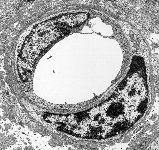
|
Perizyt; relativ undifferenzierte Bindegewebszelle,
die die von Endothelzellen begrenzten
Blutkapillaren
und Venolen mit mehreren schlanken Fortsätzen
umgreifen. Diese Pseudopodien können
sich kontrahieren und damit den Blutfluß
reduzieren. In der Gefäßentwicklung (Angiogenese) können
Perizyten sich zu glatten Muskelzellen weiterentwickeln.
Der Zellkern des Perizyten ist unten im Bild
zu sehen. |
Pericyte; an undifferentiated connective tissue
cell that develops small flat processes around blood capillaries
or venoles that are bordered by endothelial
cells. These processes are contractile pseudopods
reducing blood flow when contracted. During
formation of vessels (angiogenesis) pericytes may further develop to smooth
mucle cells. The nucleus of the pericyte
is located at the bottom of the image. |
| Perimysium |
Perimysium = Muskelhaut; derbe kollageneBindegewebshülle
(straffes paralellfaseriges Bindegewebe), das Skelettmuskelfasern
zu Bündeln und Muskeln zusammenfaßt. |
Perimysium; a dense tight connective tissue
sheath with parallel oriented collagen fibres
that envelopes each primary bundle of skeletal
muscle fibres. |
| Perineurium |
Perineurium; straffes kollagenfaseriges
Bindegewebe,
das im mehrbündeligen Nerv die einzelnen
Faserbündel zusammenfaßt, also die äußerste Bindegewebshülle
des Nerven darstellt. |
Perineurium; a tight connective tissue
sheath rich in collagen fibres investing
a fasciculus or bundle of nerve fibres. The
perineurium is the outermost border of a nerve. |
| Periosteum |
Periost = Knochenhaut; die den Knochen
umhüllende, gefäß- und
nervenreiche,
Bindegewebssschicht
mit tiefer zellreicher Kambiumschicht (Stratum cellulare, dient der Knochenbildung
und -regeneration) und faserreicher Außenschicht (Stratum fibrosum). |
Periosteum; the fibrous membrane that forms the investing covering
of bones exept at their articular surfaces;
consists of a dense external layer (Stratum fibrosum with collagen
fibres) and an inner layer of connective tissue
cells (Stratum cellulare) that function as osteoblasts when the bone is
injured. Periosteum contains numerous blood
vessels and nerve fibres. |
| Peritendineum |
Peritendineum; das eine Sehne umhüllende
lockere kollagenfaserhaltige Bindegewebe.
Das Peritendineum bildet in Sehnenscheiden das innere, der Sehne anliegende
Blatt. |
Peritendineum; a sheath of fibrous connective tissue with many collagen
fibres investing a fiber bundle of a tendon.
In the sheath of a tendon the peritendineum
forms the inner part adjacent to the tendon proper. |
Peroxisoma
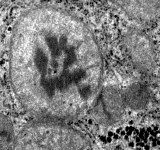
Abbildungen - images
|
Peroxisom = Microbody; Peroxidasen, Katalase und Urikase enthaltende
Zellorganelle.
--> weitere Informationen und Abbildungen |
Peroxisome = microbody; cell organelle containing peroxidase, catalase
and uricase
--> further information and images |
Phagocytosis
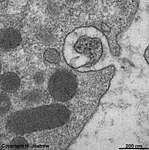
|
Phagocytose; Aufnahme lichtmikroskopisch noch erkennbarer Partikel
(> 1µm, z.B. Bakterien, Ruß) durch Ausbildung von Pseudopodien.
Umschließung des Fremdkörpers und Aufnahme desselben in eine
Zelle unter Bildung eines Phagosoms.
--> weitere Informationen
und Abbildungen |
Phagocytosis; incorporation of extracellular particles into a cell
that are still visible with a light-microscope (> 1 µm, e.g. bacteries,
dust, soot) by formation of pseudopods.
The incorporated particles are called
phagosoms. |
Phagolysosoma
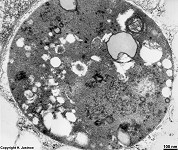
Abbildungen - images
|
Phagolysosom; durch Verschmelzung eines primären
Lysosoms mit einem Phagosom entstandenes sekundäres
Lysosom = Heterolysosom bei der Phagozytose. Hier findet intrazelluläre
Verdauung statt.
--> weitere Informationen und Abbildungen |
Phagolysosome; The secondary- or heterolysosome formed when a phagosome
fuses with a primary lysosome. Intracellular
digestion takes place in this membrane bordered cell compartment.
--> further images and information |
| Phagosoma |
Phagosom; von der Membran ehemaliger Pseudopodien
umgebener, bei der Phagocytose in die Zelle
aufgenommener Partikel, der lichtmikroskopisch erkennbar ist (Durchmesser
> 1µm). Ein Phagosom verschmilzt mit primären
Lysosomen schnell zu einem Phagolysosom. |
Phagosome; particle, > 1µm in
diameter and thus visible in the light microscope which is incorporated
into the cell and bordered by the membrane of former pseudopods.
The phagosome quickly fuses with primary lysosomes
to form a phagolysosome. |
Plasmalemma
 |
Zellmembran; Bioeinheitsmembran, die
eine Zelle umschließt
--> weitere Informationen und Abbildungen |
cell membrane; unit membrane that borders
a cell
--> further images and information |
Plasmocytus
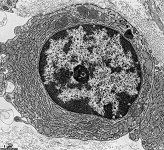
|
Plasmazelle; Antikörper (= Immunglobuline) produzierende freie
Bindegewebszelle mit ovalem bis rundlichen Kern
ohne Sekretvesikel, da die Antikörperproteine,
die im reichlich vorhandenen RER gebildet werden,
direkt durch die Zellmembran ausgeschleust
werden können. Aufgrund des des hohen RER
Gehaltes erscheint das Cytoplasma bei
lichtmikrokopischer Färbung stark basophil. Typischerweise findet
sich im Zellkern, an die Kernmembran
angelagert viel Heterochromatin,
welches weit in das Kerninnere hereinreicht. Dazwischen sind helle Euchromatinbereiche,
die von der Mitte her bis an die Kernporen
heranreichen zu erkennen. Der meist in der Mitte des Kern
liegende Nucleolus und die eben geschilderte
Chromatinanordnung haben den Begriff Radspeichenkern bei Plasmazellen etabliert.
Plasmazellen stellen die reifste Differenzierungsform der B-Lymphocyten
dar. Jede Plasmazelle ist für die Produktion nur eines spezifischen
Immunglobulins verantwortlich für welches sie als B-Vorläuferzelle
geprägt wurde.
--> weitere Informationen und Abbildungen |
plasma cell; antibody (immunglobuline) producing free
cell that migrates through the connective tissue.
It has a round or oval nucleus but no secretory
vesicles since the synthetised antibodies are small proteins that do
not need exocytosis for secretion. Plasma cells have great amounts of partly
dilated RER, thus they stain basophilic. Usually
the heterochromatin of the nucleus
is attached to the nuclear membrane
reaching towards its centre. In between the heterochromatin areas there
are less electron dense euchromatin
areas that extend from the cell centre towads nuclear
pores. With the mostly central nucleolus
the weel-spoke form of the nucleus is visible.
Plasma cells are the most differentiated form of B-lymphocytes.
Each plasma cell is responsible for production of only one specific immunglobuline
for which it was adapted when it was still a precursor B-lymphocyte.
--> further images and information |
Podocytus
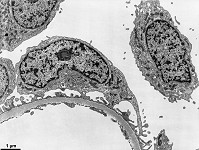
Abbildungen - images
|
Podozyt; Epithelzelle der Niere,
die das innere Blatt der Bowmann'schen Kapsel bildet. Podozyten dichten
mit ihren vielen Pseudopodien die äußere
Oberfläche der Kapillarschlingen
der Nierenglomeruli ab und sind an der Bildung der Filtrationsbarriere
auch durch Bildung von Stoffen für die Basalmembran
beteiligt. |
Podocyte; epithelial cell of the inner
sheath of Bowman's capsule in the kidneys.
With numerous footplates podocytes cover the outer surface of the capillaries
of the renal glomerula. They contribute
to synthesis of the basal lamina
and with their pseudopod-like processes
take themselves part in the renal
filtration barrier. |
Polyribosoma
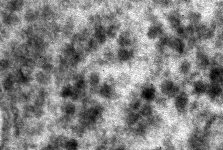
Abbildungen - images
|
Polyribosom; Aggregat
aus mehreren Ribosomen, zusammengehalten
durch messengerRNA; aktiver Komplex wo im Cytoplasma
die Proteinbiosynthese (Aufbau von Eiweißstoffen) in Form der Translation
(Umsetzung der gentischen Informationen in Aminosäresequenzen) stattfindet.
--> weitere Informationen und Abbildungen |
Polyribosome; a cluster or group of ribosomes.
They are the site of attachment for messenger RNA in the cytoplasm.
Here the translation of genetic information into determined sequences of
amino acids, i.e. the synthesis of specific proteins takes place.
--> further information and images |
Porus nuclearis
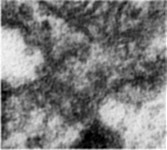
Abbildungen - images
|
Kernpore; in der Kernmembran
gelegene, elektronenoptisch erkennbare Unterbrechung der Kernwand;
über die mit einem dünnen Häutchen verschlossenen Kernporen
steht das Karyoplasma mit dem Cytoplasma
in Verbindung.
--> weitere Informationen und Abbildungen |
nuclear pore; a pore in the nuclear
membrane, which is covered by a small diaphragm regulating communication
between karyoplasm and cytoplasm.
--> further images and information |
| Proteinum transmembranosum |
Transmembranprotein: ein größerer Eiweißstoff, der
durch eine Membran, in der Regel die aus einer Lipidmoleküldoppelschicht
bestehende Bioeinheitsmembran, z.B. die
Zellmembran,
in ganzer Länge hindurchreicht, also sowohl die Außen als auch
die Innenseite der Membran erreicht. Porenproteine sind eine Sondergruppe
der Transmembranproteine, die Ionen oder bestimmte andere Moleküle
spezifisch durch ihr röhrenförmiges Inneres und damit auch durch
die Membran von Außen nach Innen oder umgekehrt transportieren. |
transmembrane protein; a larger protein that extends from
the inner to the outer surface of a unit membrane,
usually a cell membrane. Pore proteins
are a special class of transmembrane proteins that carry ions or specific
molecules through their tubular interior inside out or vice versa. |
--> 












